Discover the Croatian Danube: Fishing Village of Aljmaš (part 2)
August 21, 2022 – In TCN’s new series, Discover the Croatian Danube, we explore the little villages that lie on the banks of this mighty river. We started from the point where the river Drava “surrounds its water and name to the Danube”, in a small fishing village called Aljmaš. If anything, you might know that Aljmaš is a Marian shrine with a big modern church and that it’s somewhere in Slavonia (could be Baranja?). There is a lot more to these few streets that make the village. A very long and rich history in a geographically important and interesting position. Legends, traditions, and stories of hardship, friendship, and mischief. Learn about the former in Aljmaš part one and buckle up for the latter in the following paragraphs.
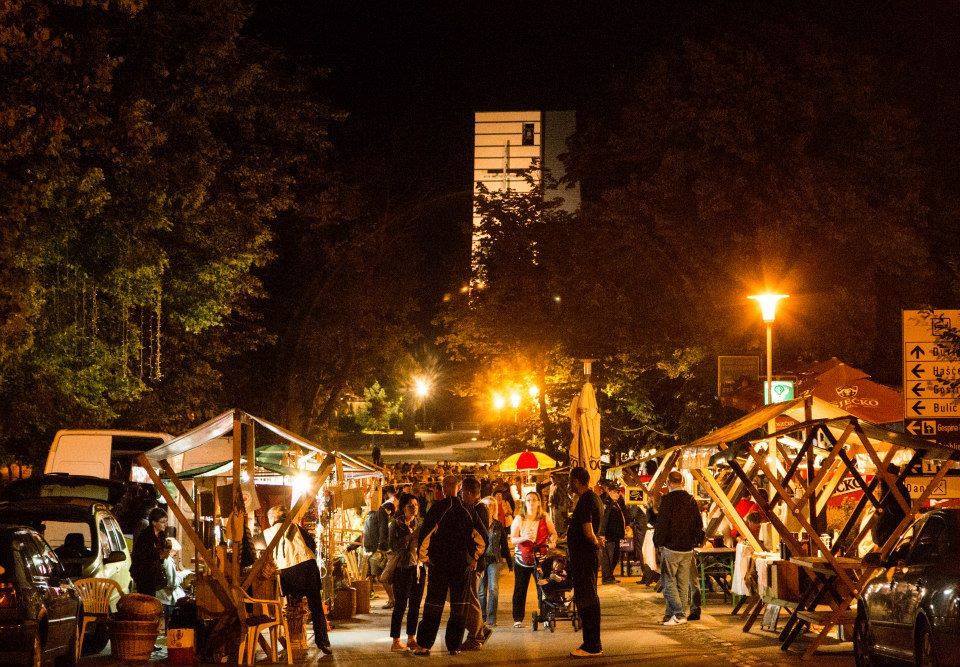
Photo: Aljmaška ribarska noć
Every village has its traditions. They are usually tied to the big holidays or otherwise important events, serve to bring people together, and are overseen by village Google. If you don’t know about the phenomenon, just ask any local grandmother about current events. In Aljmaš, its geography was used to make sure that things run smoothly. Before the modernisation of the infrastructure which took place in the 2000s, there were three canals for the rainwater to drain into the Danube. The embankments were used for social purposes where boys would gather and hang out on one, girls would do the same on another, and the third, you guessed it, was reserved for the smooth running of surveillance.
Other events couldn’t do without it, either. One of them was something called lelujle. In the spring, on Palm Sunday, there was a tradition for the ladies to let their romantic interests know who they were. This was, of course, done using old pots and pans which the girls would throw over the gates of their hopefully future husbands. This all gave the security something to do, as they would have to be the ones to either prevent the accumulation of unwanted old pottery or clear it out afterward. Usually with the words “better take this rubbish back to your mother’s house”.
The final quirky tradition presented here, and the author’s favourite is called buše. It occurs as the accompanying content, or the entertainment to go with the hard work that is the winter preparation of pig meat traditional for Slavonia. To lighten the mood, it was the task of a volunteer trickster to manage mischief. The primary goal was to play a trick on the host and acquire as much meat and snacks as possible, all while making sure that your identity remained completely hidden. Among other things, wine barrels were used to that end. The loot would then be served at a party.
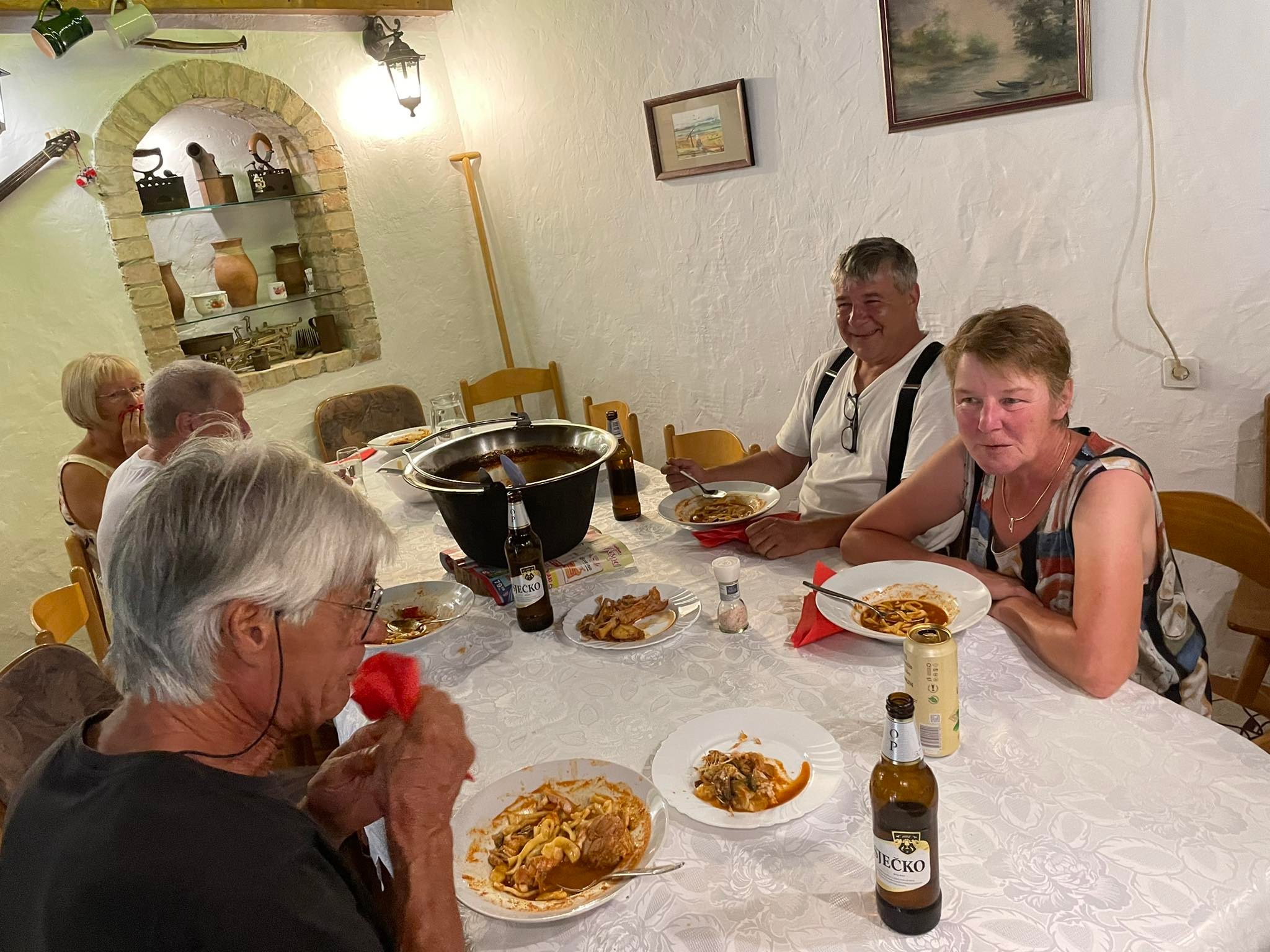
German fishing crew enjoying a delicious dinner
The Danube is the heart of Aljmaš. Fishing, camping, and picnics on the riverbanks are a way of life. Naturally, one of the most important local dishes is fish stew. This delicious, hearty meal is usually made with carp, catfish, pike, or a combination of those, over an open fire in a hanging pot, with an addition of smoked sweet and spicy paprika, onions, and wine. The ingredients can vary, and every good cook will keep their secret, but one thing is sure – love is always the primary spice. And Aljmaš breathes love for the river, for food, for good company, and a good time. A true testament to this is the annual Aljmaš Fishing Night. It was born spontaneously out of a night of good fun, cooking and a friendly cook-off between Dalmatian cooks with fish from the Adriatic Sea and local cooks with Danube fish. The eighth Aljmaš Fishing Night held in 2019 hosted over 8000 visitors who all cooked, ate, sang, and danced all night long. Unfortunately, due to the pandemic, the festival was put on temporary hold, but the organisers cannot wait to be back and have already started planning Fishing Night 2023. A little fishy told us it might be the biggest and best one yet. It is usually held in late May or early June. For more info, to get a feel of the atmosphere, and to make sure you don’t miss the next one, follow Aljmaška ribarska noć on Facebook.

Photo: Susi Petrijevčanin
The driving force of the events, traditions, and all other ways in which Aljmaš lives, is of course its residents. There might not be many, but they are the most generous and friendly bunch. Not only will they greet you with a smile, but they will also host you, show you around and feed you. One of them is Susi Petrijevčanin, a German nurse who decided to move to Aljmaš for love, the fresh air, and the perfect lifestyle. In her words, it’s a place where you can let your child go outside to play all day. They might come back muddy, tired, knees scraped, but they’ll always be happy and healthy. To ensure that a lunch of delicious fish stew is followed by lovely desserts, Susi has opened her dessert shop in Aljmaš, which you can follow here.
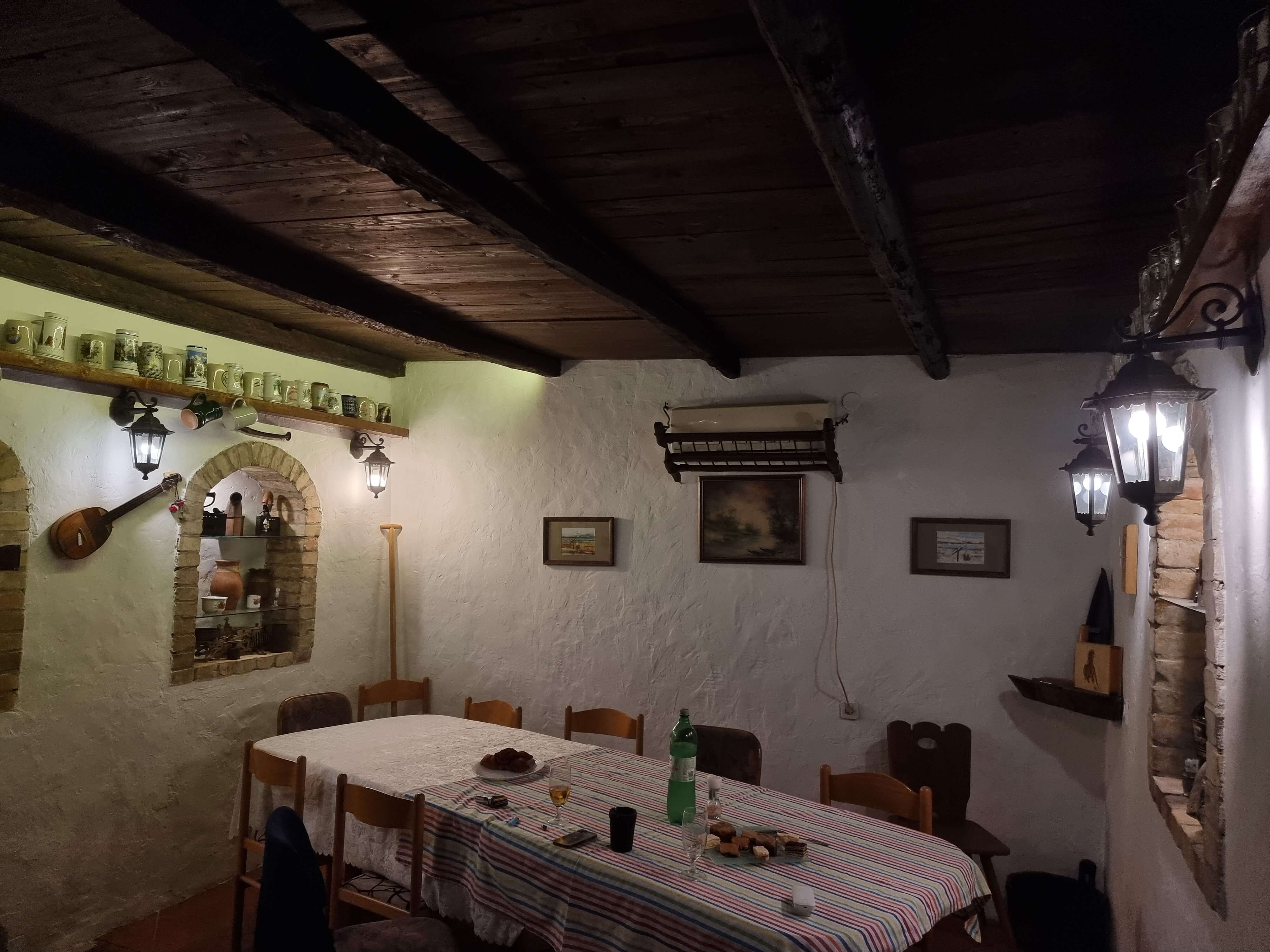
If any of this inspires you to visit Aljmaš, we encourage you to do it yesterday! Our guide Marina will be more than happy to help and will ensure that you have the best time. She will tell you a story or two about the village, her family who has lived in Aljmaš for five generations and might be traced back to Napoleon Bonaparte, as well as what the best ways are to catch and prepare fresh Danube fish. If she likes you, she might even show you her house which has stood in the village since before the 1900s. Whether it’s the original bricks, wooden structure, or the wine in the cellar, there is an incredibly special feel to the place.
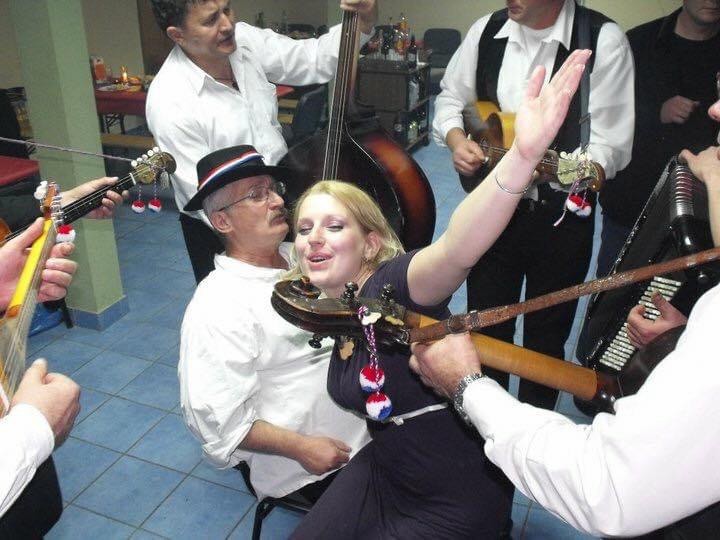
Marina with her father in traditional wear. Standard atmosphere in the village.
If you would like to contact Marina and plan your visit, email TCN This email address is being protected from spambots. You need JavaScript enabled to view it., Subject Aljmas.
How good is your knowledge of eastern Croatia? Take the CROMADS test above - how many places do you recognise?
For more, make sure to check out our dedicated Travel section.
Brace Yourselves in Slavonia: Winter is Coming and Zimnica is Now
August 18, 2022 – Picture this. You live in Slavonia. You are 16, it is the height of summer, plans include swimming in the Danube all day and partying all night. Guess again. There’s more important business. It involves plums, apricots, tomatoes, peppers, maybe beetroots. And it’s not a very weird salad. You are now old enough to make your own zimnica.
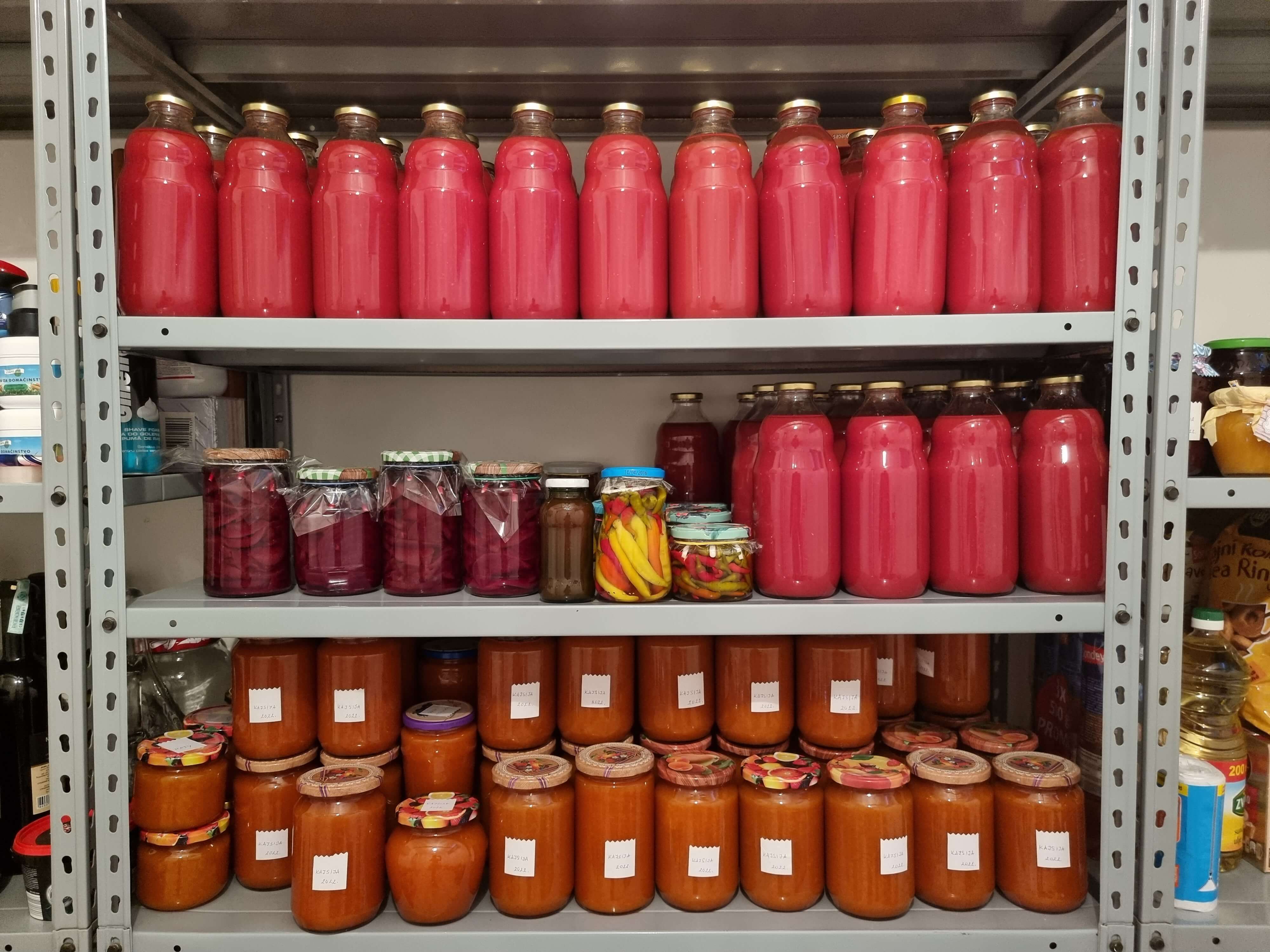
The winter staples - tomato passata, apricot and plum jam, pickled beetroots and peppers
While not a uniquely Slavonian event, zimnica, which is the Croatian word for anything that is kept specifically for the winter, plays an extremely important role in eastern Croatia. Preparing jars, bags, and dishes of fruits and vegetables for the winter is almost a form of art. Though things are different nowadays, winter in Slavonia used to be awfully long, cold, and dark, food was hard to come by, and it was of utmost importance to ensure that you preserved as much as you can. These days life is not as hard, and you can buy anything at any time, but the tradition does live on. Homegrown and homemade is always just so much better.
The preparations take place all summer long, as the fruits ripen, using various techniques. The most popular ones include pickling, jamming, and passing.
Pretty much any vegetable can be pickled using vinegar, salt, sugar, and water. The hierarchy of pickled vegetables is as follows:
1) Turšija is a mix of bell peppers, cauliflower, carrots, onions, and cucumbers, all pickled together in a plastic barrel. It takes top tier and gets served almost daily with all kinds of stews, meats, and even sandwiches, the adventure is in you.
1) Cabbage takes the same tier as turšija because it’s used to make a dish called sarma, which is the number one winter dish. It is almost mandatory to develop a love-hate relationship with it based on how often it’s made in Slavonian households.
2) Beetroots taste slightly sweeter, very red, never eaten while wearing white. Never frowned upon.
3) Solo whole bell peppers – neutral good, few hate them, few love them. Eaten if served, rarely an object of fear of missing out.
4) Other – like solo pickles, usually fetched when you run out of the good stuff.
5) Green tomatoes – now, that’s simply weird.

Just like any vegetable can be pickled, any fruit can be made into jam or rakija. Rare are jobs that are as annoying as picking up plums, apricots, peaches, pears, or apples from the ground and separating them into three buckets: good for jam, good for rakija, and good for nothing. The latter is usually completely rotten fruit, which is the most fun to pick up, and that bucket is taken to the back to be composted. The rakija bucket is dumped into a big barrel where the fruit is left to ferment, later distilled, and poured into the nicest bottles to be served on every occasion. Finally, the good fruit is eaten or used in cakes, but more importantly, jammed. There are a few different recipes for jam, depending on the fruit. The ubiquitous plum is treated as the queen and can be found in cakes, tašci, knedle, crepes, and on the breakfast table daily. Try the simple trick of cooking a large clay dish full of pitted plums with some sugar in the oven for a few hours and thank us later.
Now, you might wonder why one would go out and buy 250 kilograms of tomatoes on a Wednesday morning. Because that is market day, and the tomatoes went for a good price. And the ones from your garden were part of one too many salads. One of the most important ingredients of Slavonian cuisine is tomato sauce. Sunday lunch is unimaginable without a good broth, followed by the meat that was cooked in it served with some of the red velvety goodness. Tomato soup cures colds, cases of flu, and an array of other illnesses. It also makes for an incredibly easy and delicious dinner.
The process of preparing passata for the winter has a few steps. First, invite friends and family to help. This is a group job. Second, make sure that you’ve got some tools like a tomato press with a questionable origin, which you might or might not remember buying some 25 years ago. Even better if it’s your mother’s. Third, have some coffee. Fourth and final, work for 12 hours straight washing your tomatoes, cutting them, boiling, pressing, boiling again, bottling, and tucking for a cozy rest of 36-48 hours. Now you can rest easy knowing that you can store your 60 litres per household, getting through another long frosty winter in Slavonia.

Step no. 4
Traditional jam and tomato sauce are used in restaurants all over Slavonia and Baranja, where you can also try some of the dishes mentioned in the article, like tašci, sarma, and tomato soup. And that is just scratching the surface. Why aren’t you here?
How good is your knowledge of eastern Croatia anyway? Take the CROMADS test above - how many places do you recognise?
For more, make sure to check out our dedicated Lifestyle section.
OPG Čudesna šuma: Paradise Reimagined in Beautiful, Traditional Baranja
May 13, 2021 – OPG Čudesna šuma: How an unexpected turn of events helped world-renowned photographer Mario Romulić realise his lifelong dream.
War and genocide and the aftermath. Famine. Disease. Death. In a former life, harrowing images filled the lens of internationally renowned photographer Mario Romulić. But thankfully, we're now far from such scenes.
In fact, at OPG Čudesna šuma - Mario Romulić's home and family farm - we're pretty much far from everything. One other eco-farm is his only neighbour. Well, unless you count the llamas the Romulić family keep out back. Occasionally, through the rich green of surrounding trees, you see birds flying above the branches. Probably they're toing and froing from Kopački rit. The nearby Nature Park is less than a kilometre from OPG Čudesna šuma. Famously, the wetlands are home to over 250 species of birds. They are also the reason why Mario Romulić is here. Kopački rit Nature Park © Kopački rit Nature Park.
Kopački rit Nature Park © Kopački rit Nature Park.
“Back then, I was very occupied with Kopački rit,” remembers Mario of the time, 21 years ago, when he moved to what is now OPG Čudesna šuma. “I was working as a cameraman for people like Reuters, all over the world. The assignments would last 7-10 days and I'd be in places like Afghanistan, Rwanda, Congo, Liberia, Bosnia. It was often quite dangerous. For the next 20 days, I would spend a lot of time in Kopački rit, trying to calm my nerves. It was something like a cure after seeing all these horrible scenes. Eventually, instead of travelling every day from my home in Osijek to Kopački rit, I decided to try and find something close by. And this is what I found.”
Just as this beautiful, natural landscape in Bilje, Baranja once served as a peaceful getaway for Mario Romulić, his OPG Čudesna šuma today does the same for others. Because, after dreaming for two decades of turning this blissful plot and homestead into a forest farm and eco-village, Mario Romulić is finally turning that vision into a reality.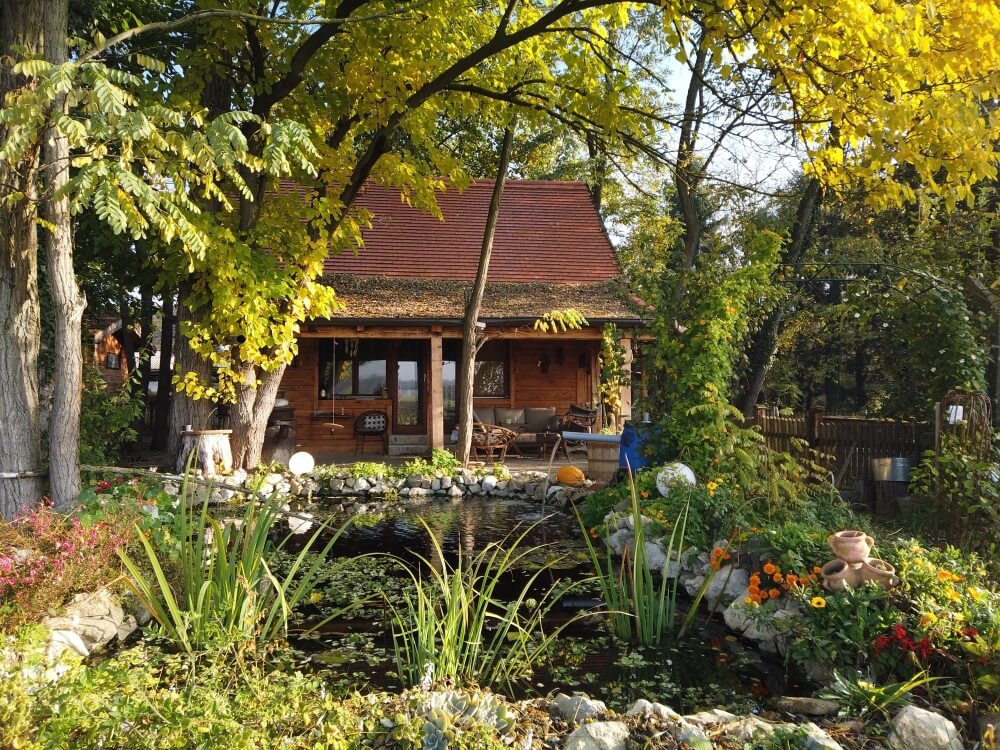 The impossibly pretty OPG Čudesna near Kopački rit Nature Park, Bilje Municipality, Baranja © OPG Čudesna šuma.
The impossibly pretty OPG Čudesna near Kopački rit Nature Park, Bilje Municipality, Baranja © OPG Čudesna šuma.
“Because of my job - first, travelling all around the world, then travelling Croatia - I did not even have much time to think about it, let alone do it,” says Mario. “But, then Corona came. Finally, I found myself at home. At last, I had time to work on my dream.”
OPG Čudesna šuma in the Month of Baranja Cooking (Mjesec baranjske kuhinje)
A group of 30 or so are Mario's guests today at OPG Čudesna šuma. They're here for a presentation of speciality cooking. It's the grand finale of the Month of Baranja Cooking (Mjesec baranjske kuhinje).
Over previous weeks, OPGs from all across the region have welcomed guests to try goulash, soups, stews, perklet and other traditional foods of the area. While visiting, they've been embraced by the beautiful landscape of Baranja. Not only have they discovered how this delightful, distinct cuisine tastes, but also they've learned exactly how it's prepared. However, they've evidently saved the best for last. On the menu today, river fish inventively cooked, accompanied by a riotous rainbow of seasonal vegetables. Seasonal vegetables of Baranja in springtime at the Month of Baranja Cooking (Mjesec baranjske kuhinje) © OPG Čudesna šuma.
Seasonal vegetables of Baranja in springtime at the Month of Baranja Cooking (Mjesec baranjske kuhinje) © OPG Čudesna šuma.
It's a beautifully sunny day, right at the start of May. It depends on your preference, but looking across this happy vista in the glorious sunshine, it's difficult to imagine this not being the perfect time to be in Baranja. Young children are raised to chest height by their parents so they can meet Mario's free-roaming llamas face-to-face. The children's faces flit between surprise, curiosity and delight. The llamas return their stare. They're used to welcoming new guests. Meeting the Romulić family llamas at OPG Čudesna šuma © Turistička zajednica Općine Bilje - Kopački rit.
Meeting the Romulić family llamas at OPG Čudesna šuma © Turistička zajednica Općine Bilje - Kopački rit.
Partially shaded by trees, the smiling adult guests sit casually on wooden benches around a central, outdoor cooking area. Several open fires display a range of traditional cooking methods. Steam rises from a cast-iron stove suspended over one. Beneath the vapours, you can make out the dish is fish paprikash. It's unmistakable because of the deeply red coloured bubbles, a result of generous amounts of paprika.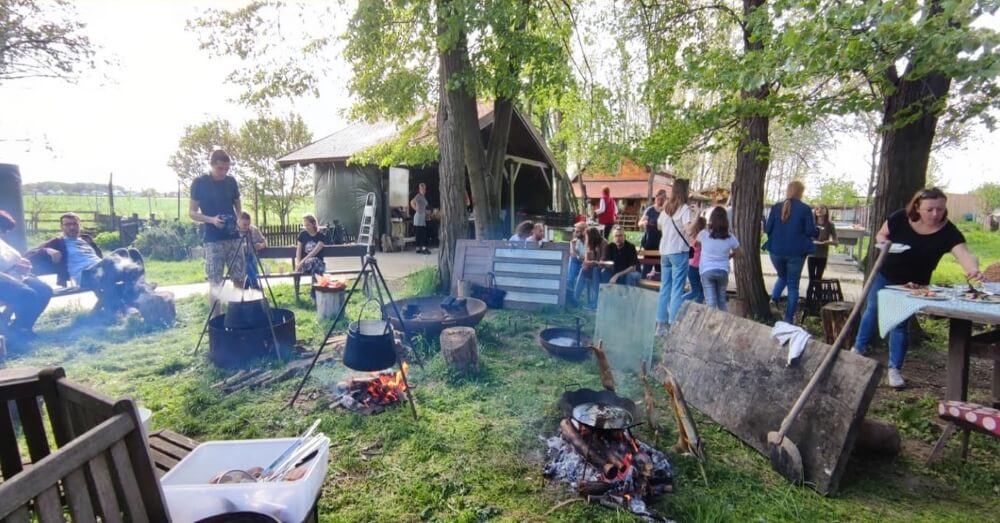 Guests enjoy a warm springtime day at OPG Čudesna šuma during the Month of Baranja Cooking (Mjesec baranjske kuhinje), as fish paprikas cooks over an open fire © OPG Čudesna šuma.
Guests enjoy a warm springtime day at OPG Čudesna šuma during the Month of Baranja Cooking (Mjesec baranjske kuhinje), as fish paprikas cooks over an open fire © OPG Čudesna šuma.
A huge bag of this paprika sits propped up, close by. It's from another organic OPG, just a kilometre or so from here. The colour is vivid, impossibly red, unrecognisable from anything store-bought. At the next fire, pike impaled on wooden sticks are placed far enough from the flickering flames so they cook slowly and do not burn.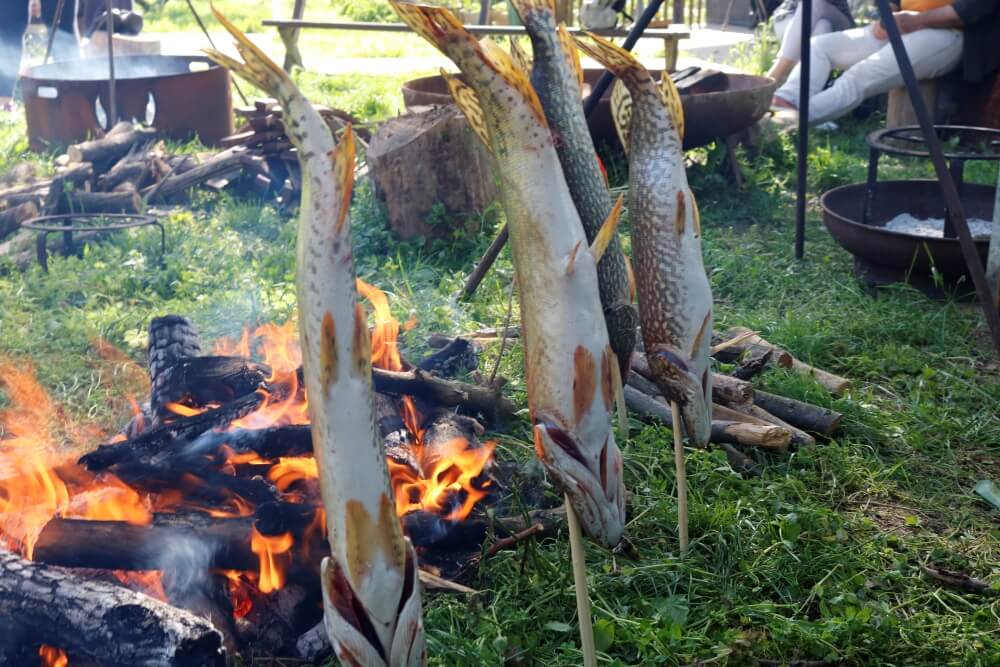 Pike impaled on sticks, cooking by an open fire at OPG Čudesna šuma @ Marc Rowlands.
Pike impaled on sticks, cooking by an open fire at OPG Čudesna šuma @ Marc Rowlands.
In the outdoor kitchen, Mario Romulić's co-chefs prepare an unending supply of fish dishes and vegetables. Carp, catfish, trout, bream. There's a bounty of fresh asparagus. It's that time of year. With the restraint of experience, they've cooked it perfectly. After the crunch of the bite, the flavour explodes. They're seasoned simply – delicious olive oil and sea salt.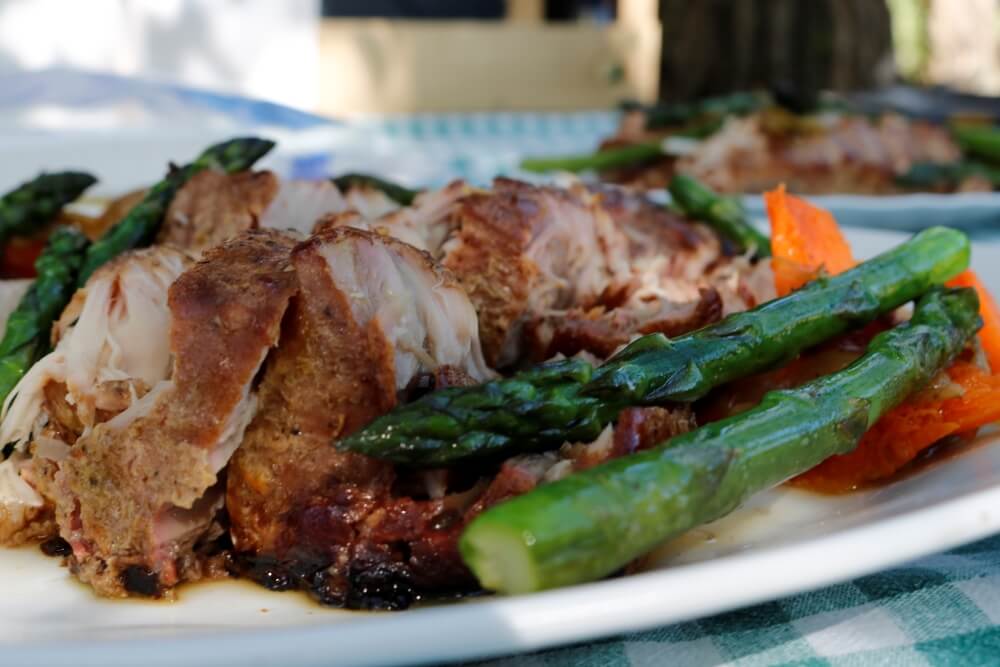 Seasonal asparagus, perfectly cooked, served with smoked river fish © Marc Rowlands.
Seasonal asparagus, perfectly cooked, served with smoked river fish © Marc Rowlands.
A group of peers – accomplished chefs from Osijek-Baranja restaurants – peak over the shoulders of Romulić's co-chefs. They're admiring the inventive techniques employed. Although, being chefs, they can't help themselves. They end up briefly forgetting their families in order to help out.
Mario Romulić, the host with the most
 Mario Romulić © Turistička zajednica Općine Bilje - Kopački rit.
Mario Romulić © Turistička zajednica Općine Bilje - Kopački rit.
After all the guests arrive, Mario Romulić holds court. Cheerily he welcomes us all to OPG Čudesna šuma and the event. Without question, the success of rural, village tourism depends on the personalities of the hosts. It's no good plonking a group of visitors in a pretty place and throwing some food in front of them. We've all seen trees, grass and food before. Rural tourism is not just about the place, it's about the experience, the ambience. And, especially, it's about the people.
Hands down, the OPGs of Slavonia and Baranja are the best in Croatia at this. The folks here are famous for their friendliness, warm welcome and big personalities. And, Mario Romulić has one of the biggest of them all.
In the research for this reportage, looking back at archive pictures of Mario Romulić is startling. During his years spent as an international photographer, he himself has been photographed many times – on assignment in distant countries, at the opening of exhibitions that have showcased his celebrated work. In most, there's an intensity to his stare. It's sometimes difficult to look at. He looks like a man who has tales you never want to hear, like a man who has seen too much.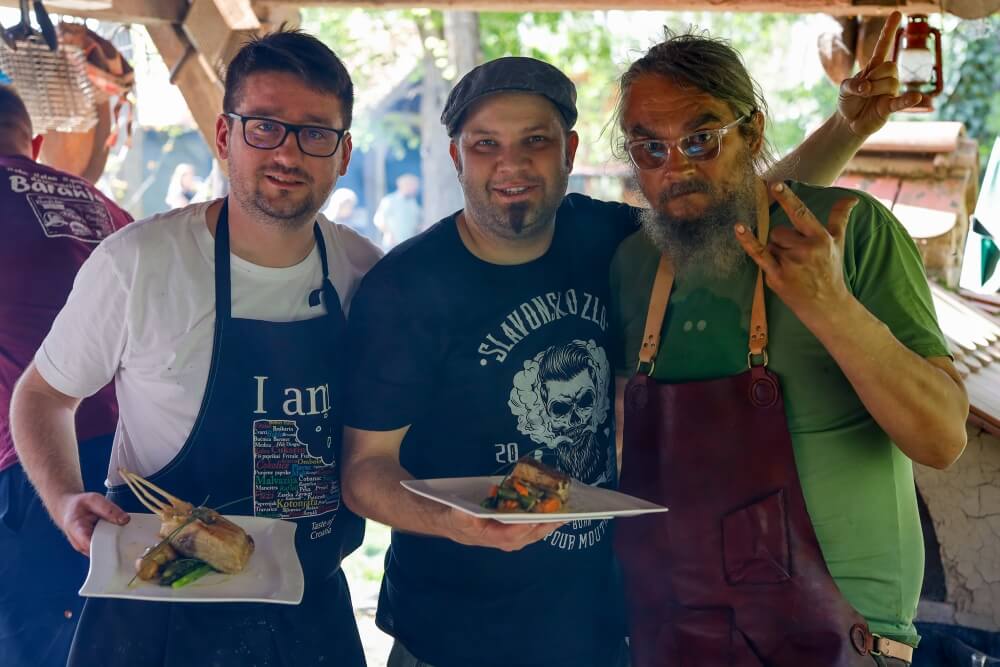 (L- R) OPG Čudesna šuma co-chef at the event Mihael Tomić, renowned Osijek chef Ivan Đukić currently of Osijek's Lipov Hlad and a happy Mario Romulić © Turistička zajednica Općine Bilje - Kopački rit.
(L- R) OPG Čudesna šuma co-chef at the event Mihael Tomić, renowned Osijek chef Ivan Đukić currently of Osijek's Lipov Hlad and a happy Mario Romulić © Turistička zajednica Općine Bilje - Kopački rit.
By comparison, the Mario Romulić that welcomes us at OPG Čudesna šuma today is unrecognisable. Sure, there's a little more grey to his long hair and beard but, otherwise, he looks incredibly healthy and happy. The intense stare is gone, replaced by a warm, wide smile that shows across his entire face. Even in early May, he has a darkened skin tone, the telltale signs of a man who spends much of the day outdoors. Romulić's enthusiasm for his guests and the event is palpable. After his sincere welcome, this enthusiasm is immediately transferred to each of his guests.
Mrs Romulić ensures everyone's glass is overflowing with wine or juice. One of Mario's teenage sons helps out with the food, while the other is taking photographs of the event. Well, someone has to do the photography now that dad wants to be a chef and host! Mario himself is engulfed in smoke. Among the other duties he's assumed today, Mario is tending a smoker. Without a doubt, this is the most revelatory cooking method we meet today.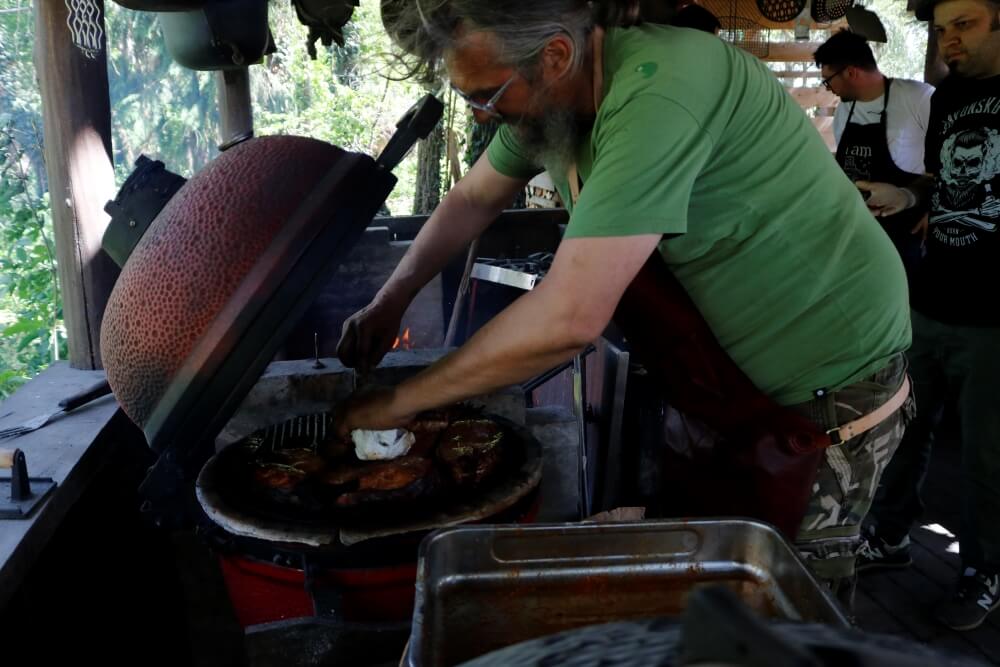 Mario Romulić tends to smoked river fish, a revelatory gastronomic experience at OPG Čudesna šuma © Marc Rowlands.
Mario Romulić tends to smoked river fish, a revelatory gastronomic experience at OPG Čudesna šuma © Marc Rowlands.
Smoked fish of Slavonia and Baranja at OPG Čudesna šuma
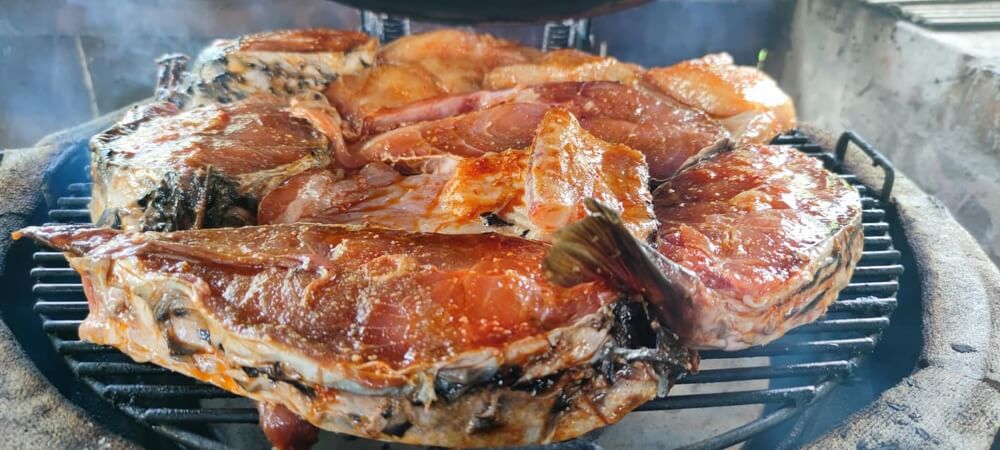 An American-style smoker, loaded with river fish. TOP TIP: A great way to stop fish sticking to the grill of your barbecue or smoker is to place them on top of a layer of lemon slices © OPG Čudesna šuma.
An American-style smoker, loaded with river fish. TOP TIP: A great way to stop fish sticking to the grill of your barbecue or smoker is to place them on top of a layer of lemon slices © OPG Čudesna šuma.
“We do have smoked fish here, but not in this way,” he says. “This is more like an American grill. I never heard of anyone trying Baranja cooking like this. Actually, I never heard of anyone nearby who has a smoker like this. The first time I tried stuka (pike) in the smoker, that was unbelievable. It's incomparable, really special.” Exquisite presentation of river fish by the enthusiastic team of OPG Čudesna šuma © Turistička zajednica Općine Bilje - Kopački rit.
Exquisite presentation of river fish by the enthusiastic team of OPG Čudesna šuma © Turistička zajednica Općine Bilje - Kopački rit.
“In Slavonia and Baranja, there are just a few ways we usually cook our river fish - carp on sticks, fish paprikash, perklet and fried fish. So, we tried something new, to expand the palette. For instance, almost nobody eats Babuška (a type of carp). They feed it instead to their pigs. It costs 5 kuna a kilo! But, if you cook it in this completely natural way, it's delicious.”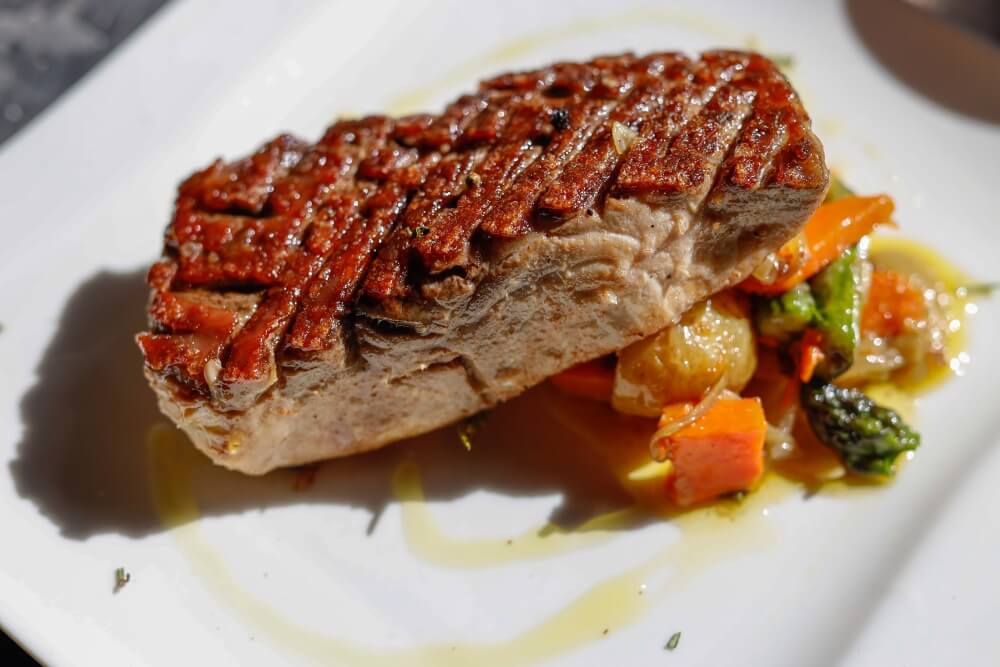 More river fish, cooked by the team of OPG Čudesna šuma © Turistička zajednica Općine Bilje - Kopački rit.
More river fish, cooked by the team of OPG Čudesna šuma © Turistička zajednica Općine Bilje - Kopački rit.
He's not wrong. Today's mountain of different smoked fish is the talk on most of the adult lips. The rich flavours surprise. Compliments and returns for second helpings ensue. Mario stands to one side, happily watching as his smoked fish secret escapes. In the future, he plans similar events based on other regional foods - Black Slavonian pig, wild meats like deer or boar. Eventually, in the seven hectares of land he owns here, he would like to expand OPG Čudesna šuma as an eco-village, with beds for visitors, a natural swimming pool and then surround it with a food forest. Big plans. It looks as though the camera may stay more permanently in the hands of his son. Because it's difficult to imagine Mario Romulić leaving his happy place and the realisation of his long-held dream. Mario Romulić in his happy place, with a friend © OPG Čudesna šuma.
Mario Romulić in his happy place, with a friend © OPG Čudesna šuma.
Both the author and Total Croatia News would like to thank the following for their invaluable help in creating this article: Ivana Jurić and the Tourist Board of Osijek-Baranja County, OPG Čudesna šuma, Mario Romulić and family, Renata Forjan and Turistička zajednica Općine Bilje - Kopački rit and Domagoj Butković of expert travel guides to Slavonia and Baranja, Kulen travel.
Srijem and Slavonia: A Taste of Happiness
April 3, 2021 - From small snacks to spicy dishes and the most delicate desserts, when it comes to food, Srijem and Slavonia are unsurpassed.
Slavonian small snacks and finger food are even tastier, for starters, if they are from the black Slavonian pig. Gingerbread, kulen, kulen cutlet, švargl, sausage, bacon, cheese, ajvar, and more. Then hearty soup, just removed from the heat, still smoked, then sarma and delicious cookies of all colors and sizes. First of all, brandy, and with every dish, the wine of the Srijem vineyards. A very ordinary day in Srijem and Slavonia will look like a real feast, so if you are a gourmet, be sure to stop by. The invitation is valid indefinitely.
It’s not that it won’t make your cheeks glow and your stomach warm. It has everything you need - a harmony of flavors: it is moderately salty, moderately thick, and somewhat spicy. The noodles melt in your mouth and red ground pepper does not cover the delicate taste of fish. It only lacks fish bones. That is why it was given an honest and straightforward name - boneless fish.
Vecernji List reports, this innovative version of one of the most popular dishes east of Zagreb was designed many years ago at the Dunav Hotel in Ilok and has since become their trademark. This hotel, otherwise a real avant-garde in the traditional Slavonian, Srijem, and Baranja cuisine, is not only known for its innovative fish, but it was also the first in this part of the country to receive a Michelin recommendation. Everyone who has eaten there at least once knows. Super price, top quality, everything is fine and fresh, and for a sweet finish, our recommendation is šnenokli. It may seem too simple to you, but that’s exactly where the charm lies. With an absolute explosion of flavors in such a traditional and everyday dish, you will want to immediately ask for a recipe from the head chef.
Good wines accompany delicate dishes, and those from Ilok, the center of the Srijem vineyards, have seduced the most demanding palates for centuries and are drunk in European courts since the princely family Odescalchi filled them in unique packages in the Old Cellars 200 years before Bordeaux and Burgundy. They are protected from traders and resellers who often confused it with that of inferior quality.
True connoisseurs and wine lovers in Ilok will enjoy the fragrant Traminers, and there is still talk of that Ilok cellars that were drunk at the coronation of Queen Elizabeth II. The grapes for the top Traminers of this most awarded Croatian winery are grown on Principovac, a famous wine-growing position and the country estate of the Odescalchi family, where his first vine was planted in 1710. Since then, this royal variety has not ceased to intrigue the wine world.
In Ilok, you have to walk through its beautiful historical core, visit the church of St. Ivana Kapistrana, the Museum of the City of Ilok in the Odescalchi Castle, the Old Cellars from the 15th and 18th centuries, and, with prior notice, at least two or three more wineries, about twenty of them on the Ilok Wine Road.
A homely, positive atmosphere, which can only be provided in Slavonia and a modern, refined interior, characteristic of fine dining restaurants in major world capitals, is how at first the new Vinkovci restaurant Lu could be described. The award-winning chef, Ana Marija Stanković, is a national champion and bronze medalist at the Culinary Olympics in Stuttgart. Fire burger, homemade smoked sausage, pork fillet, glazed pork ribs, chicken fillet in an almond crunch, french lamb rack, beefsteak, rump steak, perch fillet; you will enjoy its interpretation of traditional Slavonian cuisine; especially if you follow modern trends and above all appreciate quality food.

Restaurant Lu Vinkovci | Restraurant Lu Facebook
Although there are more and more modern restaurants and pubs, Srijem and Slavonia will wish you a warm welcome in traditional, proven good restaurants where dishes are simmered, long and slow, with a lot of heart and a few secret ingredients, just like the daughters-in-law used to do.
The final stop is Sotin, the popular Gondola restaurant, and the picnic area. It is cooked there according to traditional, carefully selected recipes. You will enjoy fragrant Slavonian sausages, the famous shepherd's pie or delicious Šokac steaks with špecli, and the greasy bread and the finest saltines homemade jam owned by Aunt Luca look so good and entice with the scents that even the most notable characters will not resist. And only when you take the first bite, that is the taste of happiness.
For more about lifestyle in Croatia, follow TCN's dedicated page.
Pozega-Slavonia Hunters Send Two Tons of Game to Earthquake Area
February 2, 2021 – In an admirably understated manner, Pozega-Slavonia hunters humbly pitched in to the relief efforts and sent two tons of game to those in the earthquake-affected area of Sisak-Moslavina
It's fair to say that in this day and age, hunters often get a bad rep. There are far more people in the world today who abstain from eating any meat – vegetarians and vegans – than those who go hunting. Changing times. For sure, it wasn't always this way.
In Croatia, hunting associations play a vital role in maintaining the beauty and accessibility of the country's rural landscape. Not that you much hear about this aspect of their undertakings. Perhaps they are typically just rather understated people?
You might easily come to that conclusion when considering the recent humanitarian action undertaken by Pozega-Slavonia hunters. Organised by the county hunting association and county officials, Pozega-Slavonia hunters from each of the region's district societies contributed in an effort to send the game taken by each – mostly deer and wild boar - to the earthquake-hit areas in Sisak-Moslavina County. They so far managed to send a whole two tons!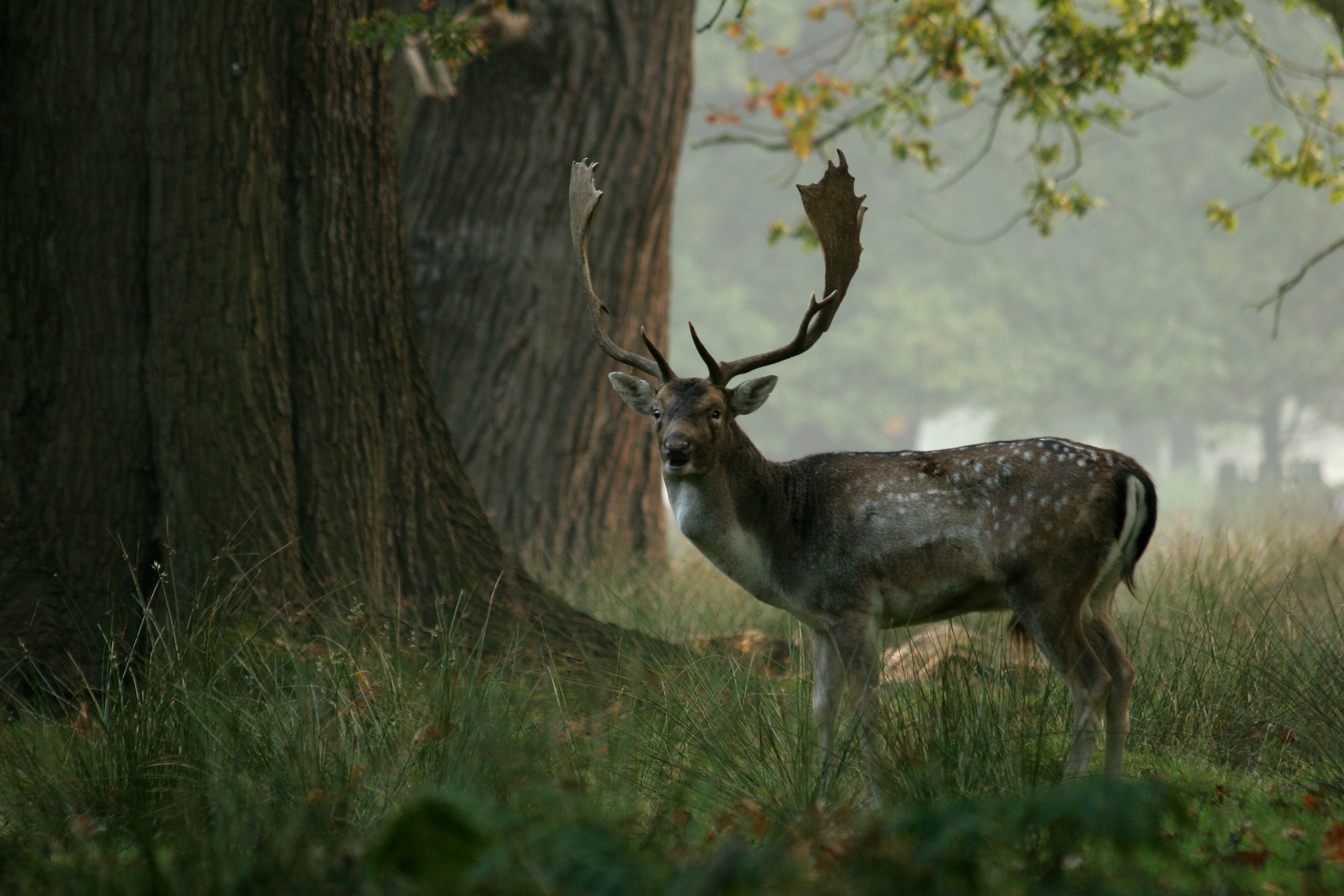
At the same time, Pozega-Slavonia hunters from the county association began collecting funds for the families of those tragically killed in the 29 December earthquake. They have so far collected some 50,000 kunas that will be directed to the intended recipients through the Croatian Hunting Association.
“This is a small help, but undertaken with an open heart,” said a representative from the County, who jointly organised the effort.
“We go to visit friends,” he said, in reference to the delivery of the Pozega-Slavonia hunters game, “and a Slavonian does not go empty-handed. We have loaded more than a ton of meat here (in this shipment), but there will be more because in co-operation with Croatian Forestry, Brod-Posavina County and the Radinje hunting ground, today we will take (in total) about three to four tons of game.”
“(Perhaps) the people of Moslavina will remember Slavonia next time they eat Slavonian čobanac (a local specialty stew, made from game) because she (Slavonia) is always thinking of her (Moslavina),” he concluded.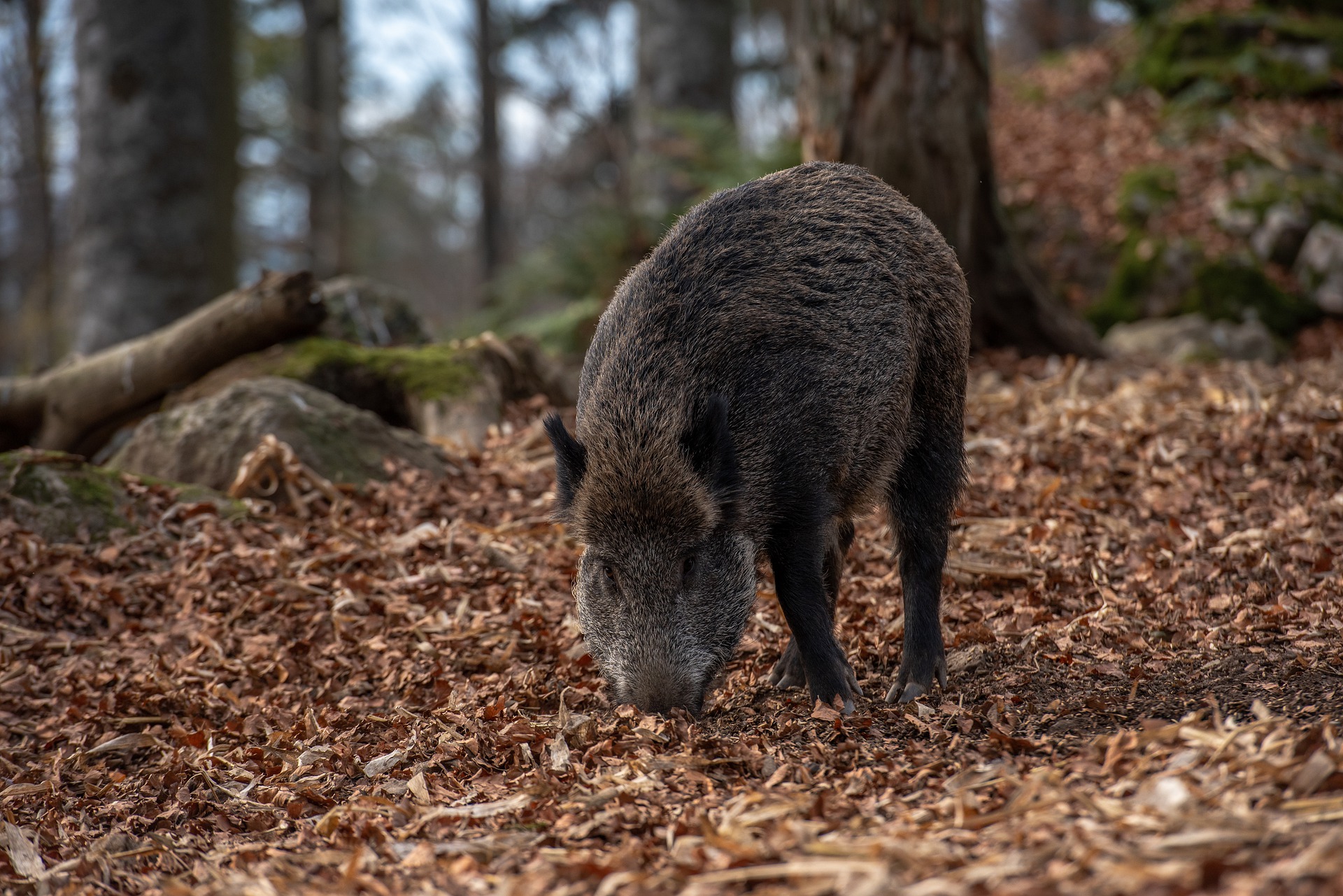
“Lovački savez Požeško – slavonske županije (Hunting alliance of Pozega Slavonia County) was the main organiser,” Mateja Tomasevic, Head of the County office told TCN. “Within it, there are 28 separate societies of Pozega-Slavonia hunters. They all participated in the humanitarian action.”
Among the 28 contributing societies were Hunting Associations 'Fazan' and 'Košuta' from Pakrac, 'Psunj' from Orljavac, 'Šljuka' from Brestovac, 'Jelen', 'Šijak', 'Sokolovac' and 'Sveti Hubert' from Požega, 'Dilj' from Buk, 'Vidra' from Sapna, Čaglin, 'Slavonac' from Kutjevo, 'Strijela' from Bektež, 'Papuk' from Biškupci, 'Sokol' from Bučje, 'Seljak' from Jakšić, 'Vepar' from Kaptol, 'Krndija' from Našice, 'Vranovac' from Vetovo, 'Šljuka' from Pleternica, 'Fazan' from Ruševo, 'Vražjak' from Sesvete, 'Sjeverni Dilj' from Seoce, 'Slavuj Gaj' from Poljana and 'Kuna' from Paka. Over 1300 residents of the county belong to one of the Pozega-Slavonia hunters associations.
Bravo!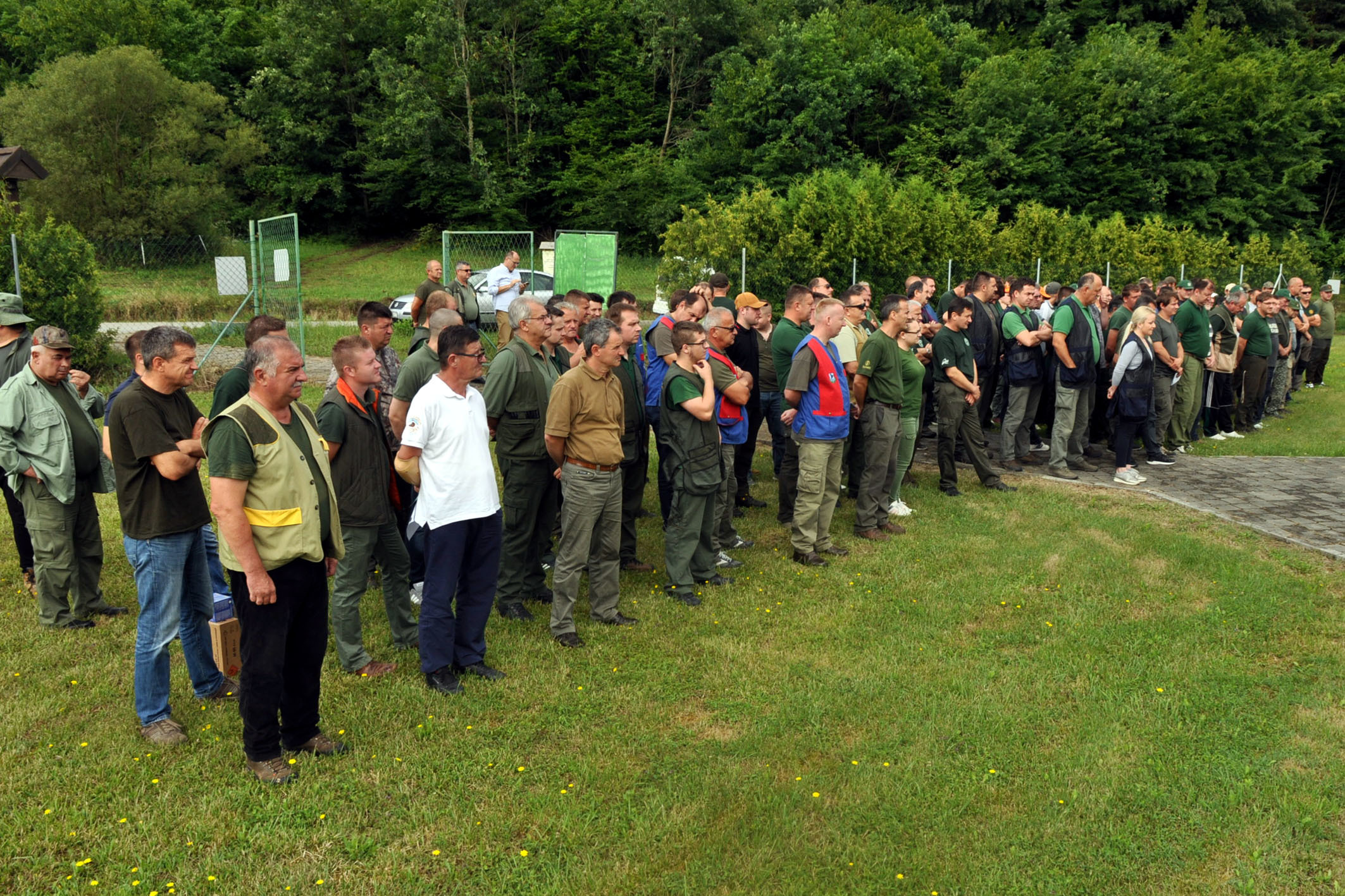 Some of the members of the Hunting Associations of Pozega-Slavonia County © Hrvatski Lovački Savez
Some of the members of the Hunting Associations of Pozega-Slavonia County © Hrvatski Lovački Savez
For the latest travel info, bookmark our main travel info article, which is updated daily.
Read the Croatian Travel Update in your language - now available in 24 languages
Join the Total Croatia Travel INFO Viber community.
Deer Killed By Train, Stolen By Train Driver, Later Caught Drunk Driving
January 26, 2021 – Road kill we've heard of. But rail kill? One Slavonia deer killed by train was due to end up on the dining table of a train driver, who stopped his train to stuff the dead deer into his cab, before later being caught drunk driving with the decapitated animal in his trunk
Road kill we've heard of. But rail kill? One Slavonia deer killed by train was due to end up on the dining table of a train driver, who stopped his train to stuff the dead animal into his cab. Alas, the čobanac (a spicy, wild meat stew, popular in Slavonia) was not meant to be. He was caught drunk-driving the next day by police at a traffic stop in Vinkovci and arrested.
It's perhaps easy to understand the train driver not wanting to look such a gift horse, or deer, in the mouth. This is not the first deer killed by train or car within the wild rural landscape of Slavonia. With the unfortunate collision having offered the opportunity for fine dining, the train driver apparently had a one track mind.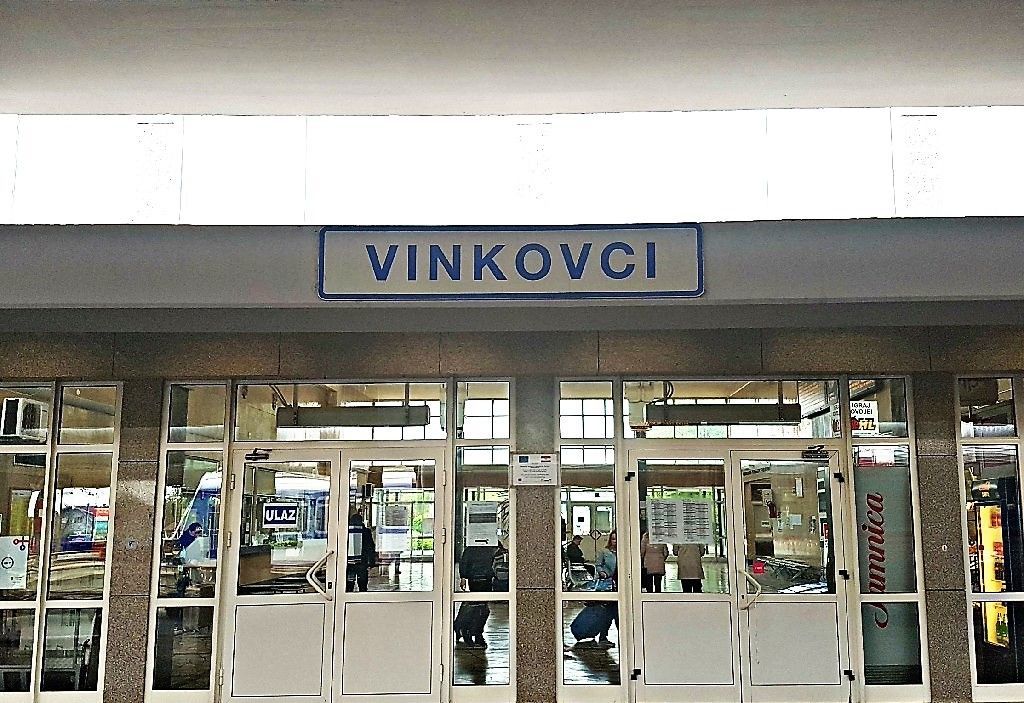
However, with the benefit of hindsight, it was perhaps not the best i-deer to retrieve the sizeable body of the deer killed by train to save for a later feast. Less easy to forgive is that he was caught with the deer while driving his car under the influence of alcohol. Such foolhardiness is no way to go about covering your tracks.
Police halted the man around 5pm on January 12 at a regular traffic roe-d stop and breathalysed him, as they correctly suspected he had been drinking. The 56-year-old man, who had Vinkovci license plates was found to be under the influence of alcohol (1.22 g / kg). However, that was just the first of the finds on the stop.
Upon searching the car trunk, police discovered the decapitated corpse of a sizeable deer. It turned out the train driver had stopped his train the day before to retrieve the animal and placed it in the driver's cab for consumption at a later date. The animal was presumably being transported home – or to a local butcher – by car the next day. But, the traffic stop put an end to any notions of a free meal.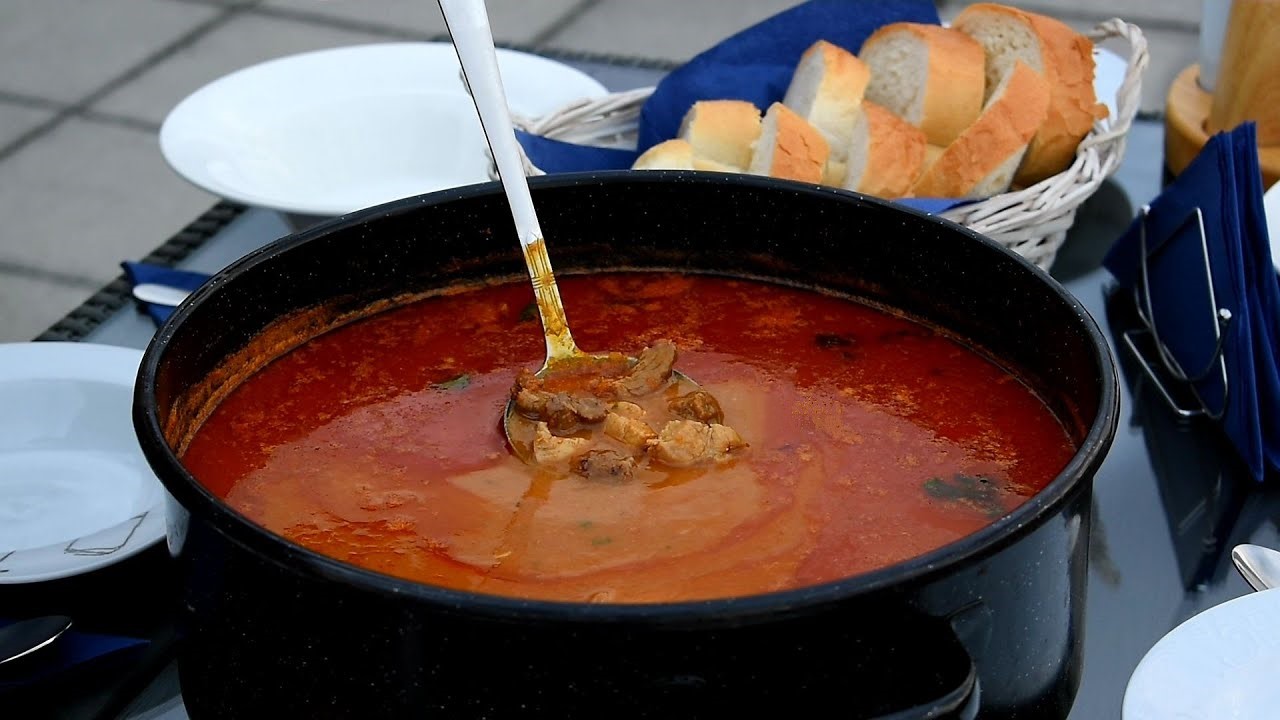 Cobanac, a hearty, spicy stew made in Slavonia using deer and other wild meats. Alas, it was not meant to be © Youtube screenshot
Cobanac, a hearty, spicy stew made in Slavonia using deer and other wild meats. Alas, it was not meant to be © Youtube screenshot
The deer corpse was confiscated and handed over to the hunting society of Stari Mikanovac for safekeeping until a warrant for an autopsy was obtained in order to determine the cause of death. Pursuant to the order of the Vinkovci Municipal State Attorney's Office, the examination of the deer carcass was performed by the Vinkovci Veterinary Institute.
For the appropriation of the deer, the police filed a complaint at the Municipal State Attorney's Office in Vinkovci against the 56-year-old for the criminal offence of theft. For his inebriated driving, the man was issued a misdemeanour order, imposing a fine of HRK 5,000 and was banned from driving a "B" category vehicle for two months. Having been charged for both excess beer and excess deer, at the time of the police road stop you could say the game was well and truly up.
Visit Osijek on the Croatian Road Less Travelled
July 8, 2020 - TCN travel series The Croatian Road Less Travelled with Marc Rowlands. In this edition, we visit Osijek in eastern Croatia, on the banks of the Drava river and look at things to do in Osijek
Situated in the far east of Croatia, the city of Osijek is a sizeable distance from the regular coastal or capital city footfall of visiting tourists. Indeed, considering its history, importance and its vast, unique appeal, its surprising just how many Croatians you meet who have also never been to Osijek. Sitting on the banks of the Drava river, the city is the de facto capital of Slavonia and the administrative centre for Osijek-Baranja county and served as a strategically important outpost in the Roman, Ottoman and Austro-Hungarian empires. Osijek was the first city in Croatia to have a tramway and, after Rijeka, the first Croatian city to be serviced by an international train route (running to Pécs in Hungary via Beli Manastir, this very line was re-opened in 2018).
Osijek's Old Town, Tvrđa, is the largest and best-preserved ensemble of Baroque buildings in Croatia. It sits spectacularly by the Drava river, separated by the defensive walls of its Hapsburg-era fort © Romulić & Stojčić
Why visit Osijek?
Osijek is an incredibly beautiful place and perhaps Croatia's only option which simultaneously offers all the thrills of a genuine city coupled with incredible nature. It's possible to walk from one end of the city to the other passing only through statue-littered parks, the air is constantly fresh and, being Slavonia, the ground is entirely flat, making it a great place for bicycle enthusiasts. It's also a great place for swimming and other water activities such as fishing, rowing and boating. Osijek has a range of great nightlife options; three catering to fans of turbo-folk, two for those who prefer tamburica and Croatian folk music, one for students, one for the alternative crowd and several bars which host live music including jazz. Specialist monthly club nights offer drum n' bass, hip hop, house music and the techno night, Traum, is well known across Croatia and fronted by two of the country's finest DJs in the genre - Insolate and Volster.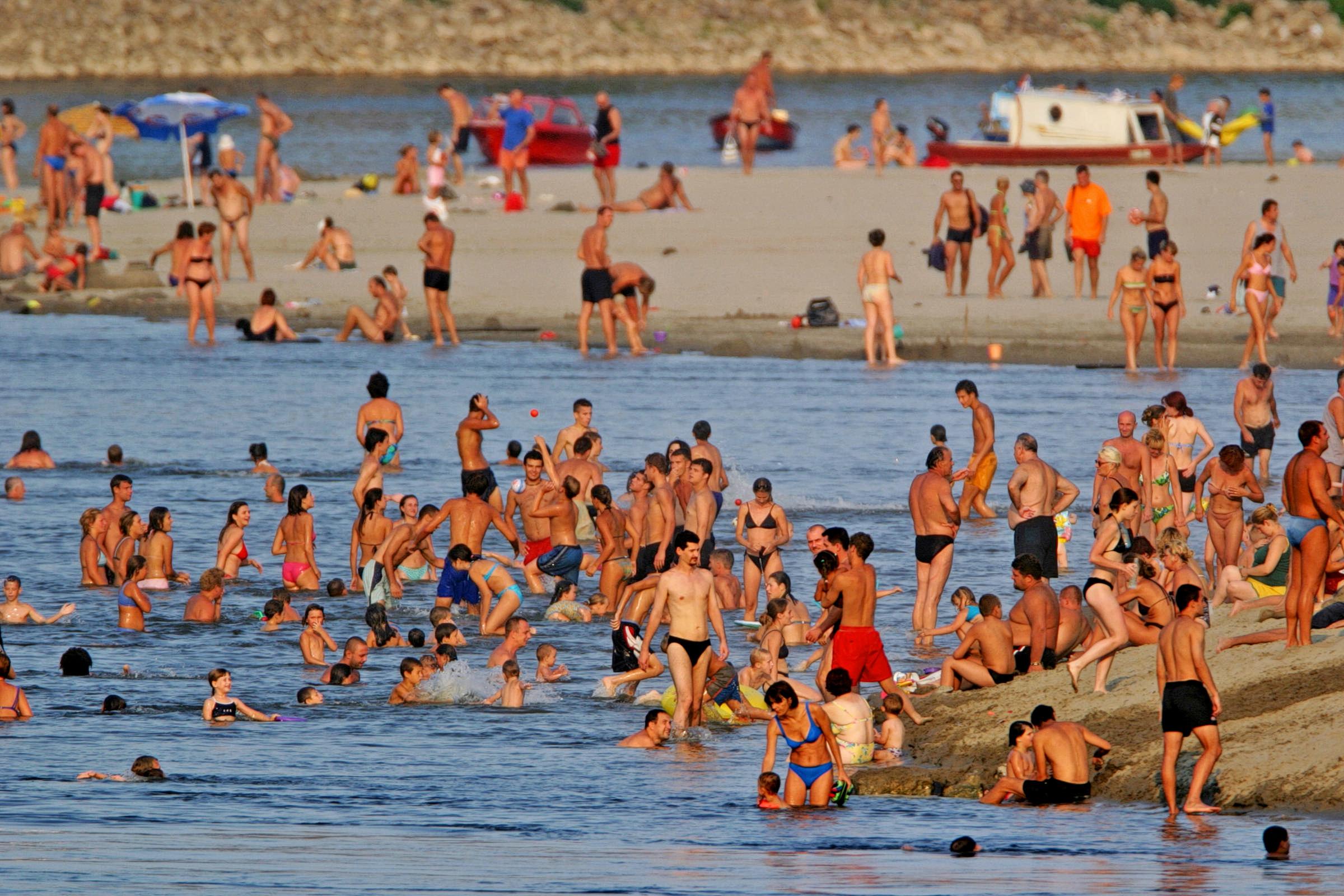
Cooling off in the Drava river, right in the heart of the city - just one of Osijek's great swimming options © Romulić & Stojčić
Osijek has, by far, the longest waterfront promenade in Croatia. Both banks of the Drava are pedestrianised. On the side of the city, the prom is lined with parks, cafes, bars and restaurants built within converted river-cruising boats. This side also holds the impressive Osijek city walls, behind which lies the Old Town centre, Tvrđa. On the opposite banks, you'll be walking alongside wild nature, with the vast open-air swimming complex Copacabana at one end and Osijek Zoo at the other. Osijek's pedestrianised bridge links both sides in the middle; it's is one of the city's most iconic sights and looks particularly special at night when colourfully lit.
Osijek pedestrian bridge by night © Romulić & Stojčić
Osijek and wider Slavonia are Croatia's least-heralded gastronomic powerhouses. The cuisine here is as unforgettable as the warm Slavonian welcome. Paprika-rich stews such as čobanac (made with locally caught wild boar and deer), fish paprikaš and perklet are a clear influence of nearby Hungary and most attempts to faithfully reproduce them outside the region fall extremely short. Although all you'll ever hear about is pršut from Dalmatia and Istria, Slavonians are masters of curing pork and even have their own high-quality breed, Slavonian black. Authentic kulen from Baranja is unquestionably the highest quality sausage from Croatia and you'd have to look hard to top Slavonia's paprika or garlic-flavoured kobasice too. In Osijek, as in its wider region, you can go to a restaurant and order one of the best pizzas you'll ever try and pay the same as you would for a starter course on the coast. 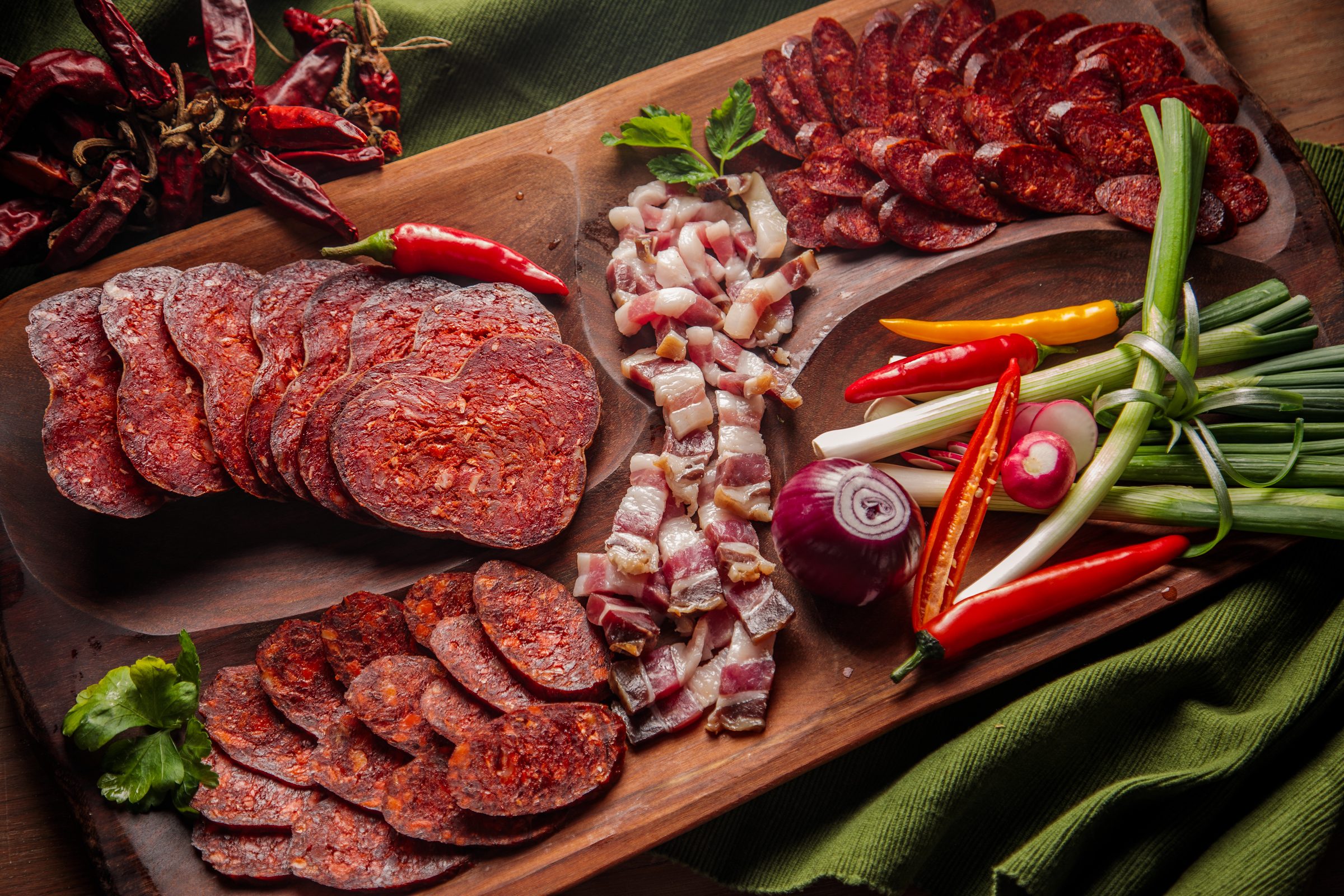
A selection of Slavonian meats. Kulen is a speciality of Slavonia and Baranja, the best quality sausage made in Croatia. It is preserved, made from top cuts of pork, richly red from paprika and versions from both Slavonia and Baranja are protected at an EU level. You can spot the one from Baranja by its irregular shape © Romulić & Stojčić
If you're a fishing or hunting enthusiast, this is also the place for you – days floating down the Drava along the 15 kilometre stretch before its confluence with the Danube can be as unforgettable as the monster-sized fish you can catch here. Osijek also makes a great permanent base for travel in the wider region, with trips across the nearby Serbian and Hungarian border offering different cuisines and culture again. The Slavonian white wine industry can also be explored from here. Equidistant between Zagreb, Budapest and Zagreb international airports, it's conveniently placed on the intrepid backpacker's route too.
Rowing on the Drava river in Osijek. The city has produced several champions in the sport © Romulić & Stojčić
How to get to Osijek
Osijek has its own airport. With established internal and international routes, this holds huge potential for the city. However, it is not without its problems. That no public transport service runs between the airport and the city is shameful. Unless you know a local, your only option is a taxi, whose fixed rates are substantially higher than the 25 kuna maximum it will cost you to travel between any two points in the city itself. Conflict between budget airlines and authorities has resulted in some international routes being cancelled. Bargaining budget airlines demand lower landing fees in return for the tourists they can deliver into the local economy. But, largely, those using the routes are not tourists; they are locals from Croatia, Hungary, Bosnia and, in particular, Serbs from Vojvodina, for whom Osijek is the most convenient airport to fly to on their way back from work in Germany or Ireland. Why should Osijek subsidise their travel? One solution may be to implement a passenger landing fee which can be fully recouped by tourists via vouchers for any accommodation they take in the city or wider Slavonia.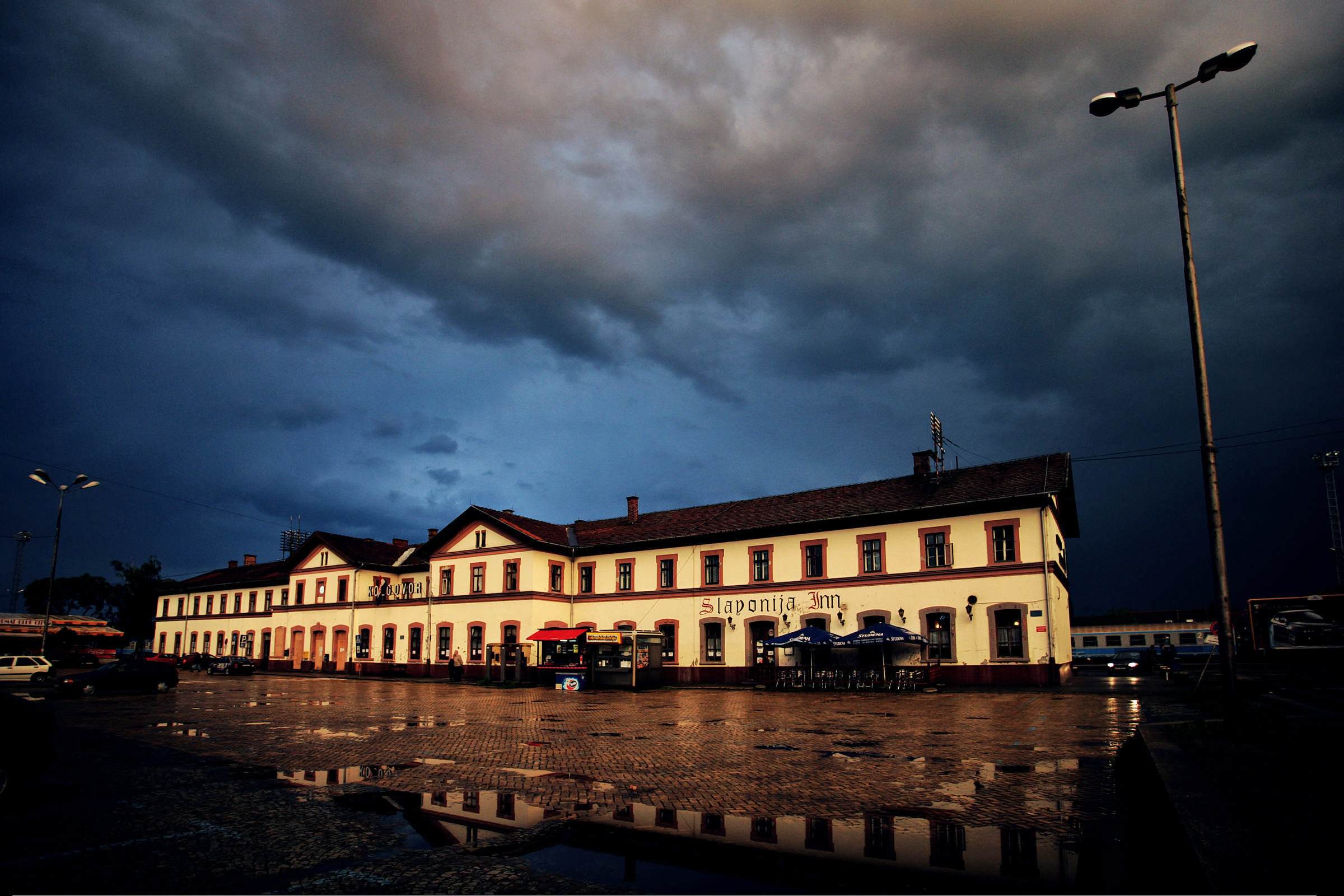
Osijek train station, one way to arrive when you visit Osijek © Romulić & Stojčić
Osijek is well connected by bus; you can travel there from Belgrade and Novi Sad in Serbia, from Zagreb, direct from coastal regions Istria, Kvarner and Dalmatia and even from Montenegro, via Dubrovnik and Imotski. It is accessible by train from all of northern Croatia and Zagreb although the lines and stock have not been updated in so long that, shamefully, it's actually quicker to take the fast train from Zagreb to Vinkovci, disembark and take a local bus to Osijek than it is to travel on the direct train there from the Croatian capital.
Where to eat: Slavonska Kuća, Kod Ruže, Vrata Baranje or Čarda kod Baranjca are brilliant, informal places to try traditional Slavonian cuisine, including all dishes mentioned previously. Further out of the city, Ugostiteljski Obrt Varga in Bilje, Citadela and Darócz in Vardarac and Didin Konak in Kopačevo are really special versions of the same. Rustika is the best sit-down pizza restaurant in the city, has a lovely summer courtyard for dining and is extremely affordable.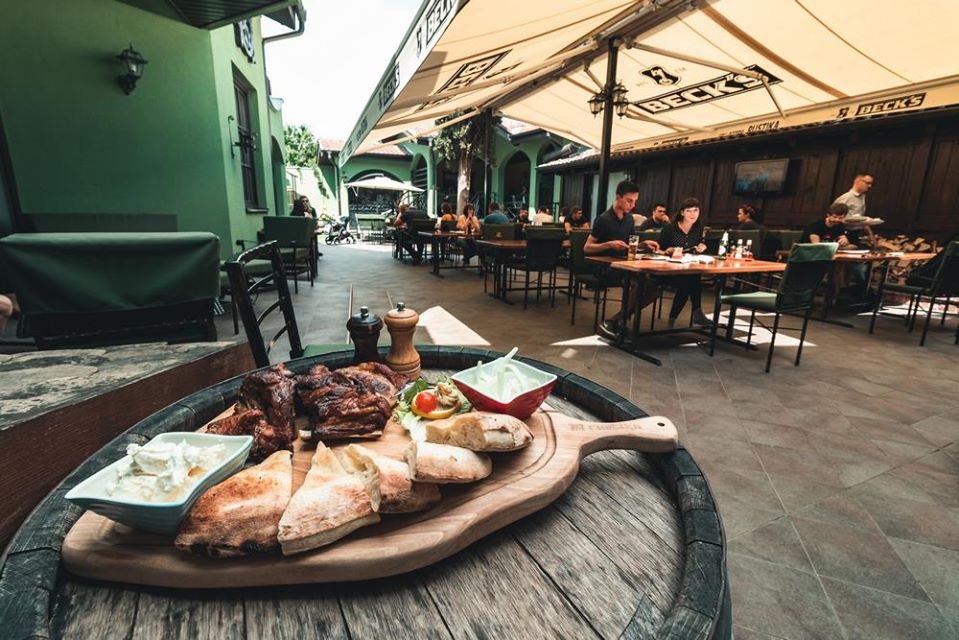
The courtyard at Rustika, a great, casual place to dine and try Slavonska pizza when you visit Osijek © Grill pizzeria Rustika
Food to go / home delivery: Lipov Hlad and Pizzeria Novi Saloon do the best home delivery pizza in the city (Rustika deliver too). Other choices are thin on the ground, save for the standard fast-food chains and pekara (the El Pan bakery on the edge of Sjenjak hood does the best burek with meat).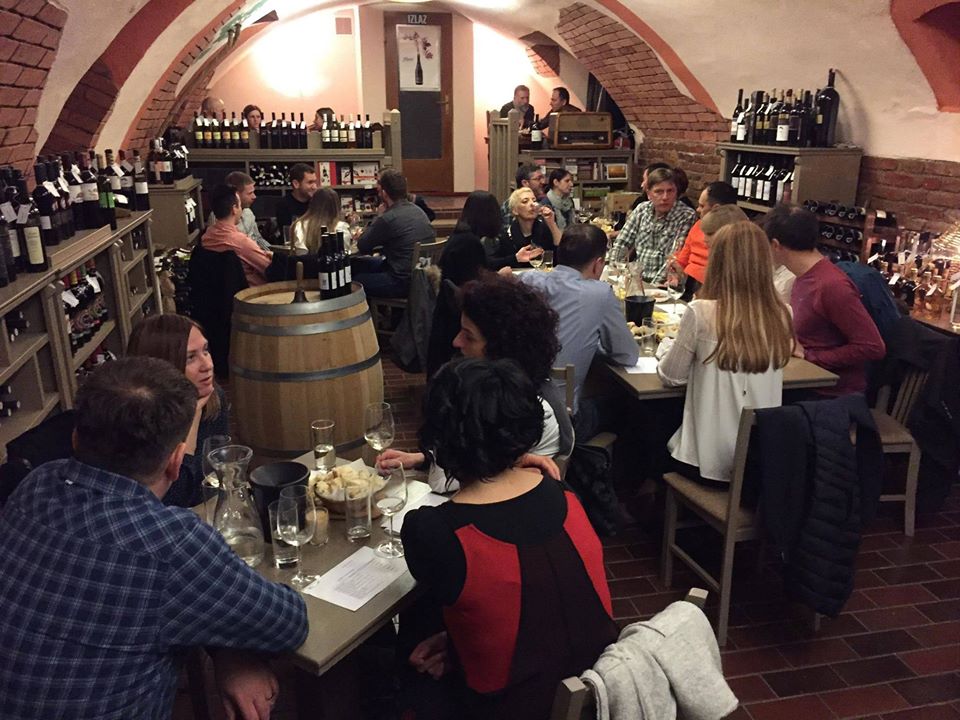
Get to know Slavonian wine when you visit Osijek © Vinoteka Vinita
Where to drink: The simple but extremely passionate Vinoteka Vinita is one of the best places to try Slavonian and Croatian wines, with many top and rarer titles sold by the glass. If you're more into beer, Beertija in the modern city centre has a great range. General Von Beckers on Tvrđa is the best place to try the leading local craft ale, Beckers, but all of the bars on Tvrđa are worth investigating and during the summer their terraces stretch far into the historic square creating a unique atmosphere.
What's new? Osijek's football club is undergoing a renaissance following its purchase by new investors. An impressive new stadium is reaching completion and you shouldn't be surprised to see this team challenging for the top domestic titles, or reaching European competitions, in the near future.
Fiš paprikaš is a Slavonian speciality. Spicy from paprika, it is made from river fish and can often be seen being cooked in a large pot over a blazing open fire if you visit Osijek in warmer months © Romulić & Stojčić
What not to miss: The protected nature park Kopački rit is wonderful to visit at any time of year, a sanctuary for all manner of wildlife, particularly rare species of birds. On Tvrđa, Slama Land Art hosts workshops, art and music events and you'll meet great creative types there. There's an extreme sports event, Pannonian Challenge, which sees international competitors visit Osijek and an annual Osijek Beer Festival which feels more like a street party. There's also a music festival called UFO. Osijek Wine Days and the celebrations celebrating the end of term at the city's sizeable university are each year accompanied by great partying and music performances. Look up the art deco Cinema Urania. At over 100 years old, it's Croatia's best independent cinema outside Zagreb. If you're looking for something a little more upmarket than the aforementioned Copacabana outdoor pools, or if you're visiting in cooler months, the renowned Bizovac Toplice is close by and there are free bus shuttle services from the city. It's a sprawling spa complex with multiple pools, offering fun and wellness therapies. But, whatever you do, don't miss the extraordinary and varied architecture of Tvrđa or Slavonian cuisine.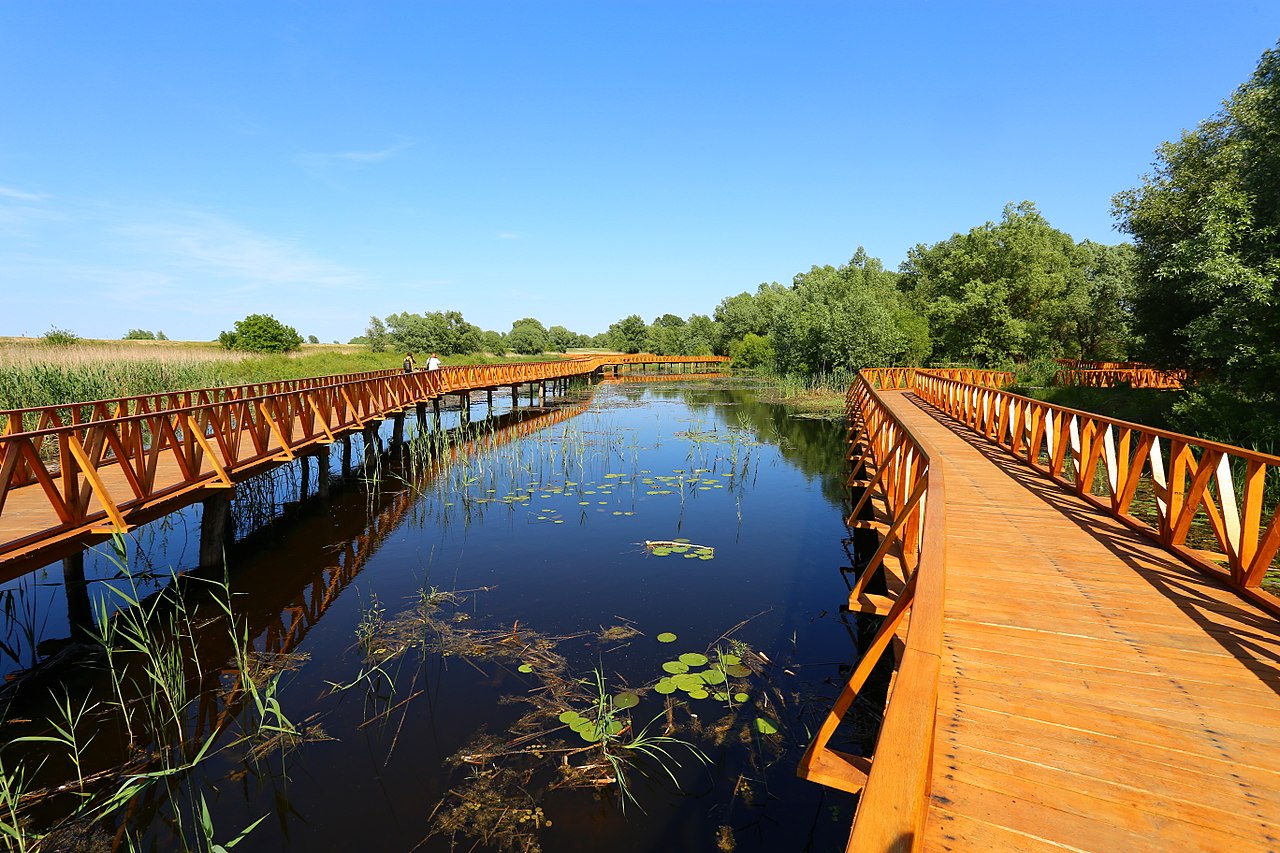
Kopački rit. The nature reserve is a must all year round when you visit Osijek © Misalalic
What to buy: If you're heading somewhere else in Croatia after you visit Osijek, take some Baranja kulen with you for posh sandwiches. Slavonia is famous for its honey, which is protected at an EU level. Take some back home with you. Local designers Lega Lega make cool t-shirts and accessories emblazoned with words exclusively used in the local dialect. Pick up some Slavonian white wine when you visit Osijek. Graševina is the most commonly made white wine in Croatia and the most popular. They make the best Graševina in Slavonia, but also look out for Chardonnay, Pinot Blanc, Pinot Gris, Sauvignon Blanc and Traminac too. There are countless excellent wine producers in Slavonia to look out for, including Kutjevo Graševina, Krauthaker, Galić, Trs, Adžić, Kolar, Enjingi, Antunović, Erdut and Iločki Podrumi.
'Lega' in local dialect is short for colleague. It is a term affectionately (and exclusively) used when speaking to someone from Osijek. Try using it when you visit Osijek © Lega-Lega
On these links you can read about the other destinations in our The Croatian Road Less Travelled series:
Ludbreg - a site of Holy pilgrimage where the historic meets the contemporary
Donji Miholjac - a hidden gem in the heart of the Pannonian basin
For the latest travel info, bookmark our main travel info article, which is updated daily.
Read the Croatian Travel Update in your language - now available in 24 languages
Join the Total Croatia Travel INFO Viber community.
Made in Croatia: Slavonski Kulen
February 11, 2019 — In this article of the Made in Croatia series, learn more about Slavonski kulen, the protected pork sausage from Slavonia.
Slavonian kulen or kulin is by far the best-known delicacy of eastern Croatian cuisine. Also, not only in Slavonia but all across Croatia, kulen is the most prestigious as well as most expensive sausage-type product.
This cured sausage made with premium pork cuts is heavily flavored with red paprika and garlic; it exudes a strong smoky aroma and has a rather piquant flavor. According to strict production rules, Slavonian kulen must be produced using the meat of pigs that have been raised in Slavonia whereas the most sought-after breeds include the black Slavonian pig and Mangulica. The animals are raised free-range and fed organically on corn, barley, and oats.
Kulen sausages are produced every year between the beginning of November and the end of March. Once they're made, the sausages are traditionally cured and smoked over beechwood for at least several months which is followed by a longstanding Slavonian tradition of enjoying kulen at Easter. However, kulen is also an essential part of other festive holiday spreads.
Kulen pairs well with mildly flavored cheeses and lighter red wines. If you happen to find yourself near Požega in June, don't miss the annual Požega kulenijada which is the oldest Slavonian festival and kulen makers' competition. As of November 2017, Slavonski kulen has been registered as a food product with a Protected Geographical Indication.
If you'd like to know more about protected Croatian food products, make sure you're following TCN's dedicated gourmet page.


